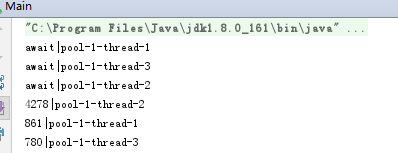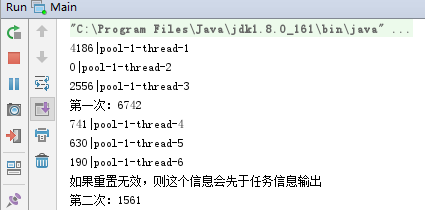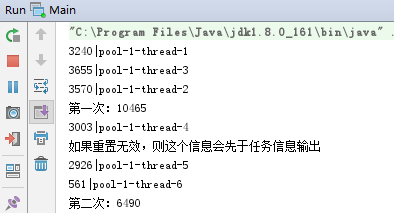CycleBarrier与CountDownLatch原理
CountDownLatch
众所周知,它能解决一个任务必须在其他任务完成的情况下才能执行的问题,代码层面来说就是只有计数countDown到0的时候,await处的代码才能继续向下运行,例如:
import java.util.*;
import java.util.concurrent.*; public class Main {
public static void main(String[] args) throws Exception { CountDownLatch latch = new CountDownLatch(3); ThreadPoolExecutor executor = new ThreadPoolExecutor(10, 15, 60L, TimeUnit.SECONDS, new ArrayBlockingQueue<>(5));
Future<Integer>[] futures = new Future[3];
for (int i = 0; i < 3; i++){
futures[i] = executor.submit(() -> {
Random rand = new Random();
int n = rand.nextInt(100);
int result = 0;
for (int j = 0; j < n; j++){
result += j;
}
System.out.println(result + "|" + Thread.currentThread().getName());
latch.countDown();
return result;
});
}
latch.await();
System.out.println("合计每个任务的结果:" + (futures[0].get()+futures[1].get()+futures[2].get()));
} }
运行结果:

源码
实际上内部十分简单,里面只有一个AQS的子类
private static final class Sync extends AbstractQueuedSynchronizer {
private static final long serialVersionUID = 4982264981922014374L;
// 它把AQS的state(同步状态)作为计数器,在AQS里,state是个volatile标记的int变量
Sync(int count) {
setState(count);
}
int getCount() {
return getState();
}
protected int tryAcquireShared(int acquires) {
// 同步状态为0,则返回1,否则返回-1
return (getState() == 0) ? 1 : -1;
}
protected boolean tryReleaseShared(int releases) {
// Decrement count; signal when transition to zero
for (;;) {
int c = getState();
// 如果状态为0则返回false
if (c == 0)
return false;
// 计数器减1
int nextc = c-1;
// CAS操作,如果内存中的同步状态值等于期望值c,那么将同步状态设置为给定的更新值nextc
if (compareAndSetState(c, nextc))
return nextc == 0; // 当计数器减到0,返回true
}
}
}
public void countDown() {
sync.releaseShared(1);
}
public void await() throws InterruptedException {
sync.acquireSharedInterruptibly(1);
}
下面看具体做了什么事情
先来看await
public final void acquireSharedInterruptibly(int arg)
throws InterruptedException {
if (Thread.interrupted())
throw new InterruptedException();
// 当计数器不等于0,返回-1,证明还有任务未执行完,进入下面方法等待
if (tryAcquireShared(arg) < 0)
doAcquireSharedInterruptibly(arg);
} private void doAcquireSharedInterruptibly(int arg)
throws InterruptedException {
// 把当前线程包装成Node放入等待队列
final Node node = addWaiter(Node.SHARED);
boolean failed = true;
try {
for (;;) {
// 获取当前线程的前驱节点,以检查等待状态
final Node p = node.predecessor();
if (p == head) {
// 如果计数器等于0,返回1,证明此时阻塞可以解除了
int r = tryAcquireShared(arg);
if (r >= 0) {
setHeadAndPropagate(node, r);
p.next = null; // help GC
failed = false;
return;
}
}
if (shouldParkAfterFailedAcquire(p, node) &&
parkAndCheckInterrupt())
throw new InterruptedException();
}
} finally {
if (failed)
cancelAcquire(node);
}
}
上面的过程可以总结为:当进入await方法后,如果此时计数器不为0,则进入死循环一直检查计数器的值,直到为0退出,此时停止等待。
再来看countDown
public final boolean releaseShared(int arg) {
// 尝试计数器减1,只有减到0才会返回true
if (tryReleaseShared(arg)) {
doReleaseShared();
return true;
}
return false;
}
private void doReleaseShared() {
for (;;) {
Node h = head;
if (h != null && h != tail) {
int ws = h.waitStatus;
// 等待状态为SIGNAL
if (ws == Node.SIGNAL) {
// 把当前节点的等待状态从SIGNAL设置成0,如果设置失败则继续循环。
if (!compareAndSetWaitStatus(h, Node.SIGNAL, 0))
continue; // loop to recheck cases
// 成功的话则卸载当前节点的所有后继
unparkSuccessor(h);
}
// 如果等待状态为0,则尝试将状态设置为PROPAGATE,如果设置失败则继续循环。
else if (ws == 0 && !compareAndSetWaitStatus(h, 0, Node.PROPAGATE))
continue; // loop on failed CAS
}
if (h == head) // loop if head changed
break;
}
}
countDown的过程可以总结为:尝试将计数器-1,直到为0,为0的时候通知等待线程。
CycleBarrier
栏栅的作用就是让指定的一批任务能够同时开始执行,比如
import java.util.*;
import java.util.concurrent.*; public class Main {
public static void main(String[] args) throws Exception {
CyclicBarrier cyclicBarrier = new CyclicBarrier(3); ThreadPoolExecutor executor = new ThreadPoolExecutor(10, 15, 60L, TimeUnit.SECONDS, new ArrayBlockingQueue<>(5));
Future<Integer>[] futures = new Future[3];
for (int i = 0; i < 3; i++){
futures[i] = executor.submit(() -> {
System.out.println("await|" + Thread.currentThread().getName());
cyclicBarrier.await();
Random rand = new Random();
int n = rand.nextInt(100);
int result = 0;
for (int j = 0; j < n; j++){
result += j;
}
System.out.println(result + "|" + Thread.currentThread().getName());
return result;
});
}
} }
运行结果

源码
进来之后首先发现的是成员变量
/** 用来保护栅栏入口的锁 */
private final ReentrantLock lock = new ReentrantLock();
/** 等待条件,直到计数器为0 */
private final Condition trip = lock.newCondition();
/** 参与线程的个数 */
private final int parties;
/* 计数器为0时要运行的命令,由用户定义 */
private final Runnable barrierCommand;
/** 当前等待的一代 */
private Generation generation = new Generation();
/**
* parties数量的等待线程。每一代等待的数量从parties到0。当调用nextGeneration或者breakBarrier方法时重置。
*/
private int count;
从这里可以看出,除了内部实现用的ReentrantLock,其工作过程无非:计数器不为0的时候线程等待;当等待线程全部就绪,也就是计数器减为0的时候重置计数器并通知所有线程继续运行。
导致计数器重置原因有两个:一个就是发生异常,将当前这一代标记为无效(broken=true);另一个就是正常就绪,开启下一代(new Generation)
核心方法dowait
// 情况一:timed=false,nanos=0L,代表一直阻塞
// 情况二:timed=true,nanos!=0L,代表在超时时间内阻塞
private int dowait(boolean timed, long nanos)
throws InterruptedException, BrokenBarrierException,
TimeoutException {
final ReentrantLock lock = this.lock;
lock.lock();
try {
// 获取当前这一代
final Generation g = generation; // 如果当前这一代已经销毁,抛异常
if (g.broken)
throw new BrokenBarrierException();
// 测试当前线程是否被中断
if (Thread.interrupted()) {
// 将broken设置为true,代表这一代已经销毁,重置count;然后通知所有等待线程
breakBarrier();
throw new InterruptedException();
}
// count 减1
int index = --count;
// 如果减1之后变成0,证明等待线程全部就绪。
if (index == 0) { // tripped
boolean ranAction = false;
try {
// 如果用户定义了额外的命令,则执行
final Runnable command = barrierCommand;
if (command != null)
command.run();
ranAction = true;
// 开启下一代(通知所有等待线程,重置count,new一个新的Generation)
nextGeneration();
return 0;
} finally {
if (!ranAction)
breakBarrier();
}
} // loop until tripped, broken, interrupted, or timed out
// 如果减1之后不等于0,也就是还有其它线程没有就绪,那么进入此循环,直到就绪或者被销毁,或者被中断和超时
for (;;) {
try {
if (!timed)
// 未定义超时,则一直阻塞
trip.await();
else if (nanos > 0L)
// 等待指定的超时时间
nanos = trip.awaitNanos(nanos);
} catch (InterruptedException ie) {
if (g == generation && ! g.broken) {
breakBarrier();
throw ie;
} else {
// We're about to finish waiting even if we had not
// been interrupted, so this interrupt is deemed to
// "belong" to subsequent execution.
Thread.currentThread().interrupt();
}
} if (g.broken)
throw new BrokenBarrierException(); if (g != generation)
return index; // 超时,则销毁这一代,通知所有等待线程并重置count
if (timed && nanos <= 0L) {
breakBarrier();
throw new TimeoutException();
}
}
} finally {
lock.unlock();
}
}
总结
两个工具实现思路都很简单,唯一我思考的是,为什么CountDownLatch只能用一次?
CycleBarrier很明显,它无论正常执行或者发生异常中断都有重置count的逻辑。
而CountDownLatch则没有重置的逻辑,那么,到底是CountDownLatch不能重置还是仅仅因为没有重置的逻辑。为此我把CountDownLatch的代码照搬,然后加上了简单的重置方法,如下:
import java.util.concurrent.TimeUnit;
import java.util.concurrent.locks.AbstractQueuedSynchronizer; public class MyCountDown { private static final class Sync extends AbstractQueuedSynchronizer {
private static final long serialVersionUID = 4982264981922014374L; Sync(int count) {
setState(count);
} /**
* 新加
* @param count
*/
void reset(int count){
// 重新设置状态
setState(count);
} int getCount() {
return getState();
} protected int tryAcquireShared(int acquires) {
return (getState() == 0) ? 1 : -1;
} protected boolean tryReleaseShared(int releases) {
// Decrement count; signal when transition to zero
for (;;) {
int c = getState();
if (c == 0)
return false;
int nextc = c-1;
if (compareAndSetState(c, nextc))
return nextc == 0;
}
}
} private final Sync sync; private final int count; public MyCountDown(int count) {
if (count < 0) throw new IllegalArgumentException("count < 0");
this.sync = new Sync(count);
this.count = count;
} public void await() throws InterruptedException {
sync.acquireSharedInterruptibly(1);
} public boolean await(long timeout, TimeUnit unit)
throws InterruptedException {
return sync.tryAcquireSharedNanos(1, unit.toNanos(timeout));
} public void countDown() {
sync.releaseShared(1);
} public long getCount() {
return sync.getCount();
} public String toString() {
return super.toString() + "[Count = " + sync.getCount() + "]";
} /**
* 新加
*/
public void reset(){
// 调用重置的方法
this.sync.reset(count);
}
}
测试:
import java.util.*;
import java.util.concurrent.*; public class Main {
public static void main(String[] args) throws Exception { MyCountDown myCountDown = new MyCountDown(3);
ThreadPoolExecutor executor = new ThreadPoolExecutor(10, 15, 60L, TimeUnit.SECONDS, new ArrayBlockingQueue<>(5));
Future<Integer>[] futures = new Future[3];
for (int i = 0; i < 3; i++){
futures[i] = executor.submit(() -> {
Random rand = new Random();
int n = rand.nextInt(100);
int result = 0;
for (int j = 0; j < n; j++){
result += j;
}
System.out.println(result + "|" + Thread.currentThread().getName());
Thread.sleep(new Random().nextInt(2000)); // 模拟耗时
myCountDown.countDown();
return result;
});
}
myCountDown.await();
System.out.println("第一次:" + (futures[0].get() + futures[1].get() + futures[2].get()));
myCountDown.reset(); // 重置 for (int i = 0; i < 3; i++){
futures[i] = executor.submit(() -> {
Random rand = new Random();
int n = rand.nextInt(100);
int result = 0;
for (int j = 0; j < n; j++){
result += j;
}
System.out.println(result + "|" + Thread.currentThread().getName());
Thread.sleep(new Random().nextInt(2000)); // 模拟耗时
myCountDown.countDown();
return result;
});
}
myCountDown.await();
System.out.println("如果重置无效,则这个信息会先于任务信息输出");
System.out.println("第二次:" + (futures[0].get() + futures[1].get() + futures[2].get()));
} }
输出

如果换成CountDownLatch
import java.util.*;
import java.util.concurrent.*; public class Main {
public static void main(String[] args) throws Exception { CountDownLatch latch = new CountDownLatch(3);
ThreadPoolExecutor executor = new ThreadPoolExecutor(10, 15, 60L, TimeUnit.SECONDS, new ArrayBlockingQueue<>(5));
Future<Integer>[] futures = new Future[3];
for (int i = 0; i < 3; i++){
futures[i] = executor.submit(() -> {
Random rand = new Random();
int n = rand.nextInt(100);
int result = 0;
for (int j = 0; j < n; j++){
result += j;
}
System.out.println(result + "|" + Thread.currentThread().getName());
Thread.sleep(new Random().nextInt(2000)); // 模拟耗时
latch.countDown();
return result;
});
}
latch.await();
System.out.println("第一次:" + (futures[0].get() + futures[1].get() + futures[2].get())); for (int i = 0; i < 3; i++){
futures[i] = executor.submit(() -> {
Random rand = new Random();
int n = rand.nextInt(100);
int result = 0;
for (int j = 0; j < n; j++){
result += j;
}
System.out.println(result + "|" + Thread.currentThread().getName());
Thread.sleep(new Random().nextInt(2000)); // 模拟耗时
latch.countDown();
return result;
});
}
latch.await();
System.out.println("如果重置无效,则这个信息会先于任务信息输出");
System.out.println("第二次:" + (futures[0].get() + futures[1].get() + futures[2].get()));
} }
输出

所以可以得出结论,CountDownLatch不是没有办法重置,只不过没有写相关逻辑。当然这个问题如果我说错了,望指正。
CycleBarrier与CountDownLatch原理的更多相关文章
- join和countDownLatch原理及区别详解
先上结论 原理 join 原理:在当前线程中调用另一个线程线程 thread 的 join() 方法时,会调用该 thread 的 wait() 方法,直到这个 thread 执行完毕(JVM在 ru ...
- CountDownLatch原理分析
CountDownLatch原理分析 CountDownLatch是一个同步工具类,它允许一个或多个线程一直等待,直到其他线程执行完后再执行.例如,应用程序的主线程希望在负责启动框架服务的线程已经启动 ...
- Java多线程系列--“JUC锁”09之 CountDownLatch原理和示例
概要 前面对"独占锁"和"共享锁"有了个大致的了解:本章,我们对CountDownLatch进行学习.和ReadWriteLock.ReadLock一样,Cou ...
- 【分布式锁】05-使用Redisson中Semaphore和CountDownLatch原理
前言 前面已经写了Redisson大多的内容,我们再看看Redisson官网共有哪些组件: image.png 剩下还有Semaphore和CountDownLatch两块,我们就趁热打铁,赶紧看看R ...
- CountDownLatch原理详解
介绍 当你看到这篇文章的时候需要先了解AQS的原理,因为本文不涉及到AQS内部原理的讲解. CountDownLatch是一种同步辅助,让我们多个线程执行任务时,需要等待线程执行完成后,才能执行下面的 ...
- CountDownLatch原理及使用场景
CountDownLatch是通过一个计数器来实现的,计数器的初始值为线程的数量.每当一个线程完成了自己的任务后,计数器的值就会减1.当计数器值到达0时,它表示所有的线程已经完成了任务,然后在闭锁 上 ...
- CountDownLatch原理
正如每个Java文档所描述的那样,CountDownLatch是一个同步工具类,它允许一个或多个线程一直等待,直到其他线程的操作执行完后再执行.在Java并发中,countdownlatch的概念是一 ...
- Java多线程系列--“JUC锁”10之 CyclicBarrier原理和示例
概要 本章介绍JUC包中的CyclicBarrier锁.内容包括:CyclicBarrier简介CyclicBarrier数据结构CyclicBarrier源码分析(基于JDK1.7.0_40)Cyc ...
- Java多线程系列--“JUC锁”11之 Semaphore信号量的原理和示例
概要 本章,我们对JUC包中的信号量Semaphore进行学习.内容包括:Semaphore简介Semaphore数据结构Semaphore源码分析(基于JDK1.7.0_40)Semaphore示例 ...
随机推荐
- .NET同一个页面父容器与子容器通信方案
主界面: 关键主页面代码: <div id="EditDiv"> <iframe src="javascript:void(0)" id=&q ...
- open*** 搭建
pptp 互联网上服务商给拦截.不稳定. opevpn 1.为了保证OpenVPN的安装,需要使用easy-rsa秘钥生成工具生成证书 [root@m01 ~]# yum install easy-r ...
- spring原理之四种基本标签的解析
四种标签 在spring的配置文件中存在四种基本的标签分别是:beans,bean,import,alias 四种标签的功能: beans:定义一个单独的应用配置(测试配置,开发配置等),在服务器部署 ...
- liteos信号量(八)
1. 概述 1.1 基本概念 信号量(Semaphore)是一种实现任务间通信的机制,实现任务之间同步或临界资源的互斥访问.常用于协助一组相互竞争的任务来访问临界资源. 在多任务系统中,各任务之间需要 ...
- input子系统四 input事件处理【转】
转自:https://blog.csdn.net/qwaszx523/article/details/54139897 转自http://blog.csdn.net/coldsnow33/articl ...
- shell 字符菜单管理
1.创建一个脚本func.sh 脚本如下func2.sh #!/bin/bash function menu(){ title="My Menu" url="www.la ...
- 201871010107-公海瑜《面向对象程序设计(java)》第八周学习总结
201871010107-公海瑜<面向对象程序设计(java)>第八周学习总结 项目 内容 这个作业属于哪个课程 https:// ...
- Provider和Consumer的搭建(六)
创建三个Maven Project: dubbo-service:公共模块,包括服务接口(packaging:jar) dubbo-service-impl:服务提供方,提供服务接口的具体实现,需要依 ...
- 洛谷 P3998 [SHOI2013]发微博
洛谷 P3998 [SHOI2013]发微博 洛谷传送门 题目描述 刚开通的 SH 微博共有n个用户(1Ln标号),在这短短一个月的时间内, 用户们活动频繁,共有m 条按时间顺序的记录: ! x 表示 ...
- CF306C White, Black and White Again
CF306C White, Black and White Again 洛谷评测传送门 题目描述 Polycarpus is sure that his life fits the descripti ...
